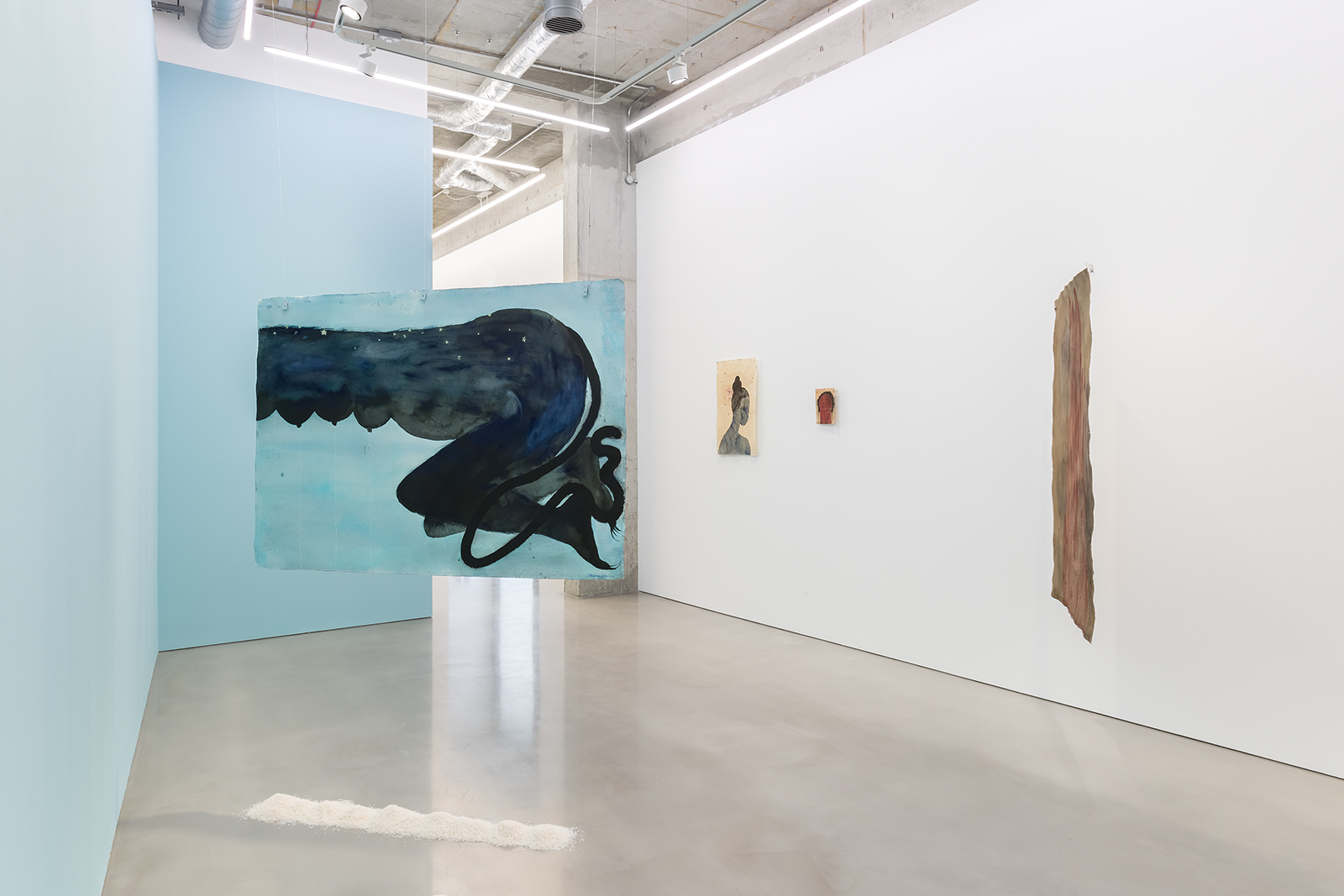


Large scale paintings are suspended in space at Chioma Ebinama’s first exhibition at Maureen Paley, allowing the viewer to see both sides of the works against a backdrop of pastel-coloured walls.
The Empress (2021) is a large painting of a chimeric beast resting on her front, hands crossed. It takes its name from the tarot card where the female figure holds a sceptre. Shifting the iconography of the divinatory figure, Ebinama’s empress holds a golden flower in her hand slithering snake-like towards her ear. The figure is dark and hairy, milk is pouring from her numerous breasts and then transforms itself into piles of rice on the floor of the gallery. The Empress has power to feed all, providing both breast milk and solid food.
Two large abstract works hang to the left of The Empress, giving her a fictional landscape to reign over. The blackness of her body stands out against the pale blue background. “I have always felt self-conscious of using black to depict people of African descent because I feel it’s part of a visual language rooted in Black subjectivity mediated by the White gaze,” explains Chioma Ebinama in an interview, “so I tend to reserve it for deities”.
Two smaller figures hang on the walls, and like The Empress they are drawn using black sumi ink and then washed with colour. The layers of the colours are carefully absorbed on the paper. They also have a symbolic use, allowing Ebinama to represent the duality of her figures “although they have human features, they are not human”, she explains.
Human and animal, deities and mediators between natural and supernatural elements populate this exhibition. The title of the show has little to do with actual shells but refers to how in the act of creation we build a “protective shell, a careful space for our own vulnerability against the "indiscriminate instability" of the external world”.
Two small scale portraits of female heads retain their titles in Igbo language. Obi Uto (joy) and Igba Gharie (ambivalence) refer to Chioma Ebinama’s upbringing vacillating between cultures. Her own name Chioma in Igbo cosmology refers to chi being one’s personal god or destiny, guardian angel or double-spirit, a direct connection to ancestors. The name ‘Chioma’ means literary ‘good god’ but also ‘lucky’, or ‘favoured’.
In the next room comes the voice of Chioma Ebinama reading a poem, Prayer for when fear strikes at dawn, 2021. Describing how anxiety can surge, it concludes with an image of “a tiny ant (…) under a hot and cloudless blue sky”. The contrast of the incredibly small and incredibly vast brings the poem to its end: “there are many ways to live a life”.
Almost as an illustration to this image, the main drawing in this space depicts a bumblebee on a flower caressed by a large female figure. The figure is wrapped in a fabric decorated with a pattern taken from a Mbari sculpture, a lost tradition of Igbo culture that merges together architecture, sculpture, bas relief and painting. These works of art had cosmological functions and were used to make offerings to the feminine Earth and its spirit of fertility, creativity and morality.
This exhibition creates an atmosphere to reflect upon duality, spirituality, religion, mythology, geomancy, feminism and Nigerian culture. It seems a space to tell stories and reveal secrets. Like in a ritualistic edifice Chioma Ebinama creates a space to rest, reflect and recharge from the instability and uncertainty around us.
Ilaria Puri Purini
Curator of Programmes
Maureen Paley, 60 Three Colts Lane, London E2 6GQ. Open Wednesday to Saturday, 11.00–18.00. Exhibition continues until 9 January 2021. www.maureenpaley.com